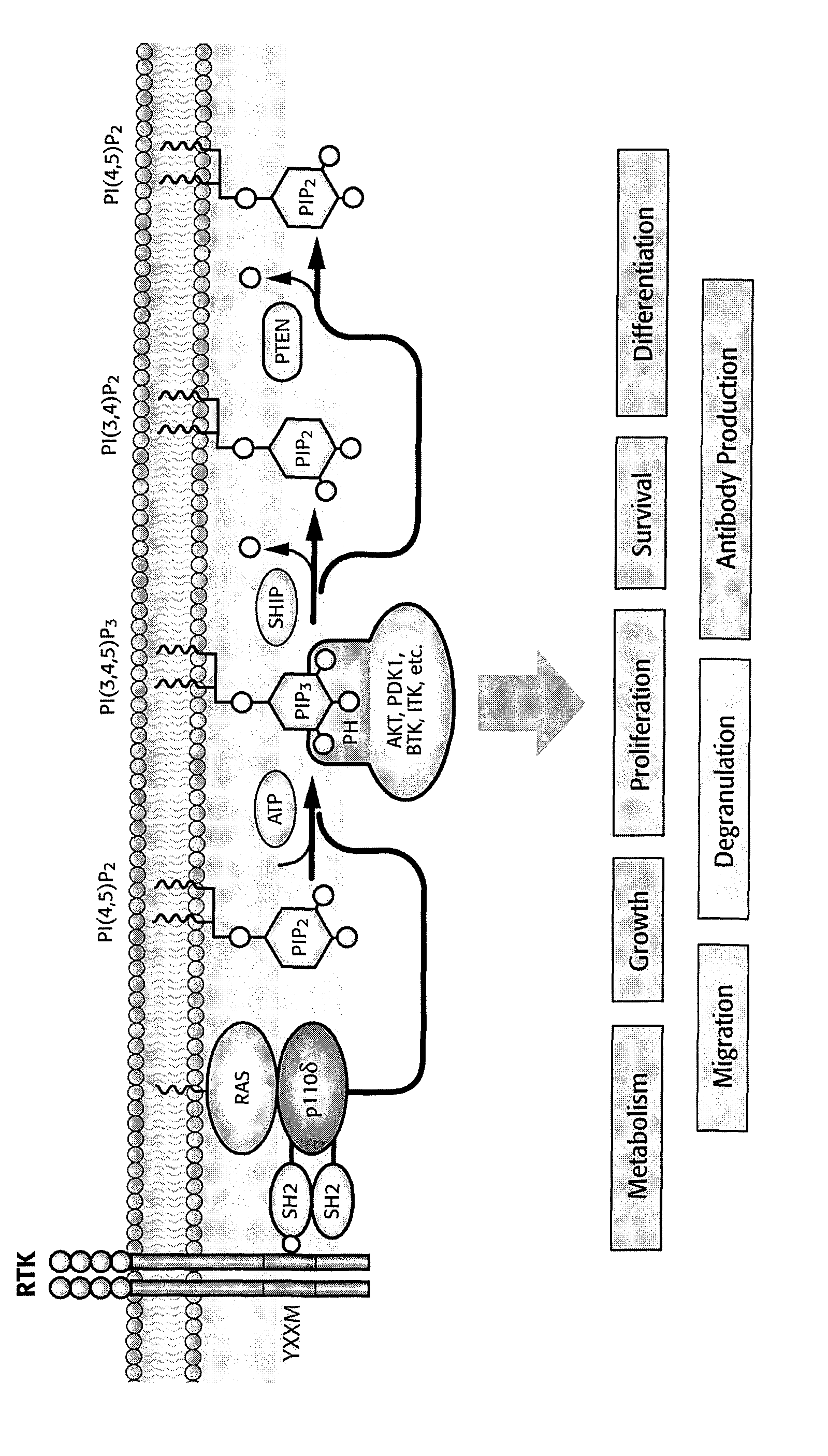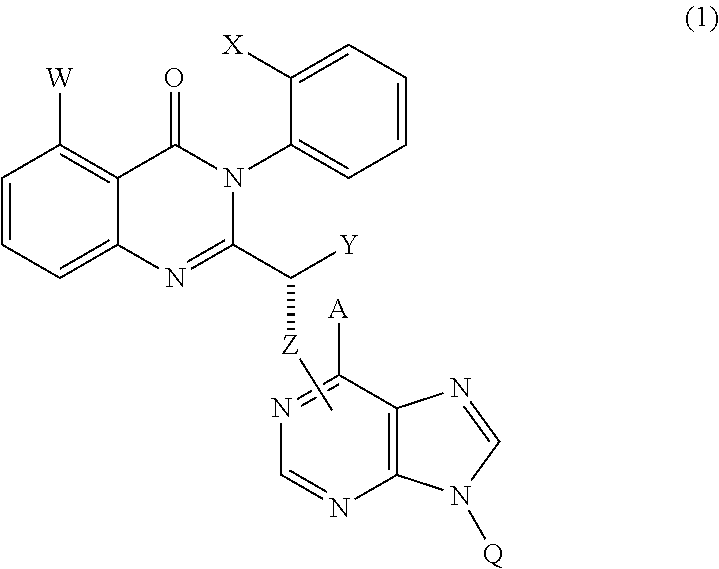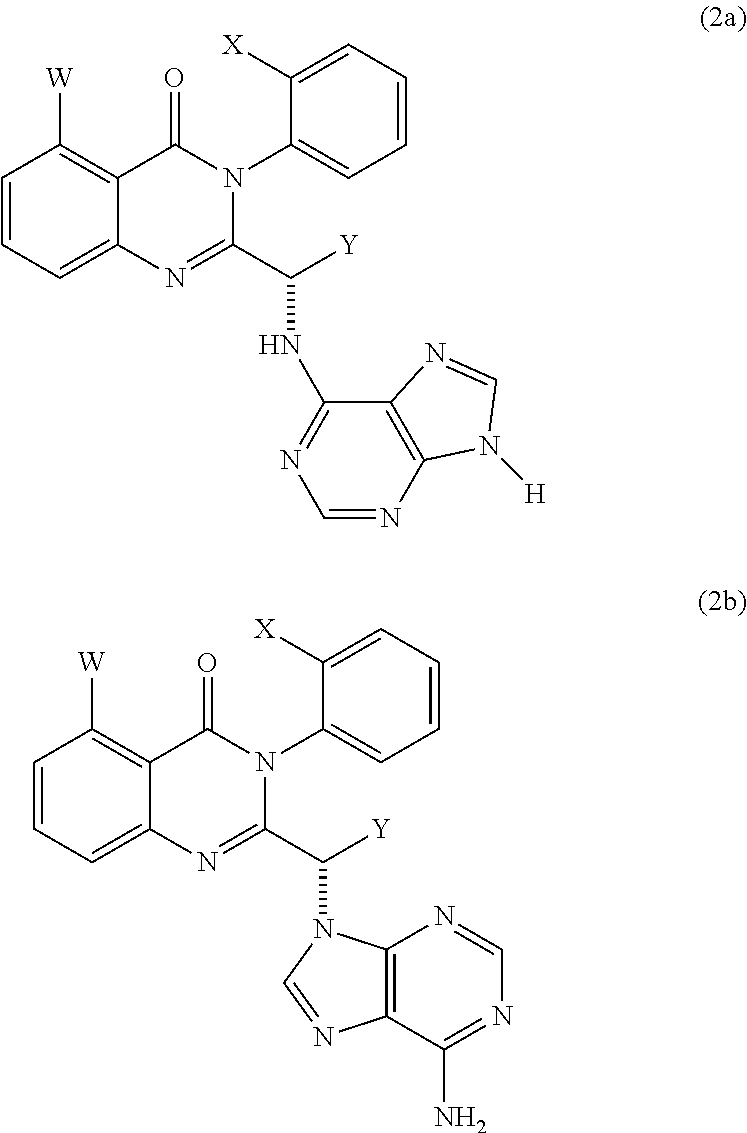Treatment of liver disorders with PI3K inhibitors
a technology of pi3 k inhibitors and liver disorders, applied in the direction of biocide, drug composition, metabolic disorders, etc., can solve the problems of increasing the frequency of liver disorders, not always predictable what, etc., and achieve the effect of reducing the likelihood of undesired side effects
- Summary
- Abstract
- Description
- Claims
- Application Information
AI Technical Summary
Benefits of technology
Problems solved by technology
Method used
Image
Examples
example 1
Preparation of 2-((6-amino-9H-purin-9-yl)methyl)-5-methyl-3-o-tolylquinazolin-4(3H)-one
[0276]2-amino-6-methylbenzoic acid is reacted with 2-chloroacetyl chloride to produce the 2-(-2-chloroacetamido)-6-methylbenzoic acid. Reaction with o-toluidine and phosphoryl trichloride yields the cyclized intermediate. Further reaction with diBOC-protected adenine give the BOC protected product, which is deprotected resulting in 2-((6-amino-9H-purin-9-yl) methyl)-5-methyl-3-o-tolylquinazolin-4(3H)-one (2c).
[0277]The atropisomers of compound (2c) may be resolved by high-pressure liquid chromatography (HPLC).
example 2
Preparatory HPLC Separation of Atropisomers
[0278]This example demonstrates the separation of the two atropisomers of compound (2c) using HPLC.
[0279]A small sample of the enantiomeric mixture was dissolved in isopropanol at a concentration of 1.45 mg / mL and 5 μL injected into a normal phase column using the following conditions: CHIRALPAK® IA, 4.6 mm ID×250 mm L, 40 / 60 / 0.1 hexanes / IPA / DEA, 0.8 mL / min, 30° C. Two peaks are resolved at 8.7 min. and 13.0 min These analytical conditions and HPLC trace were used to identify the compositions of the separated products.
[0280]2.80 g of compound (2c) was separated on a CHIRALPAK® IA preparative column using 40 / 60 / 0.1 hexanes / IPA / DEA mobile phase at room temperature and using a detection wavelength of 275 nm. Two enantiomers were isolated, (2c′) and (2c″), and were cleanly separated from each other. It was not immediately determined which peak corresponded to which atropisomer.
[0281]1.24 g of the first eluted enantiomer, atropisomer was isolate...
example 3
Treatment of NASH in Pten Knock-out Mice
[0284]Sato, et al. describe production of Pten KO mice that are a suitable model for certain NASH patient populations, and exhibit all stages of NASH (inflammation; fibrosis' and carcinogenesis), beginning by about 10 weeks of age. Compounds of the invention can therefore be shown to be effective for treating NASH by their efficacy in delaying progression of symptomology in such Pten KO mice.
[0285]Pten KO mice as described by Sato, et al. (Hepatology Res., vol 34, 256-65 (2006)) are produced as described, and are treated with a compound described herein beginning at 6 weeks of age. The compound can be administered orally or by injection, at an initial dosage of 100 mg / kg / day. Progression of NASH is measured as described in Sato, and is compared to progression in untreated (control) Pten KO mice. Dosage can be adjusted up or down in the treated mice at 10 weeks of age, depending upon the effectiveness of the initial dosage. The mice are assesse...
PUM
| Property | Measurement | Unit |
|---|---|---|
| particle size | aaaaa | aaaaa |
| concentration | aaaaa | aaaaa |
| time | aaaaa | aaaaa |
Abstract
Description
Claims
Application Information
 Login to view more
Login to view more - R&D Engineer
- R&D Manager
- IP Professional
- Industry Leading Data Capabilities
- Powerful AI technology
- Patent DNA Extraction
Browse by: Latest US Patents, China's latest patents, Technical Efficacy Thesaurus, Application Domain, Technology Topic.
© 2024 PatSnap. All rights reserved.Legal|Privacy policy|Modern Slavery Act Transparency Statement|Sitemap



